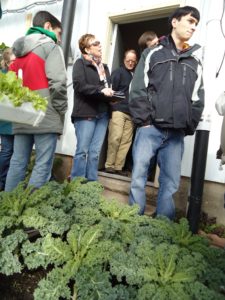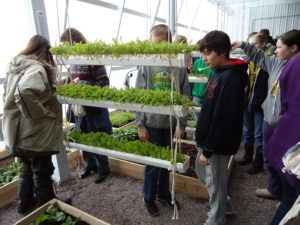Throughout the Milan Local Foods Workshop, every speaker and tour mentioned the power of the sun. Audrey Arner of Moonstone Farm started the day off by inspiring the students and explaining to them, “every one of you is a spot of light and creative potential to change western Minnesota through harvesting the sun”. She mentioned that this included everything from high-tech approaches such as man-made solar panels to traditional methods such as harvesting photosynthesis. She also discussed farming, her farm’s philosophy of perennial polyculture, and various ecosystems. She emphasized that we are all part of the solution and we’ll need to use our creativity to figure out how we’ll eat, travel, and live in the future.

Next the students traveled to Carol Ford’s greenhouse to see some of these ideas in action. They learned how she captures as much of the sun’s energy as possible through the design of her passive solar greenhouse and how she operates it. She encouraged the students to learn through doing and encouraged them to experiment in their own greenhouses or hers. One local student presented on the experiments related to soil content that she had done in Carol’s greenhouse. The students valued hearing about what Carol and the student who worked with her have learned about greenhouses and growing in a northern climate through their own experiments.
The next greenhouse that the students toured was Elk’s Bluff, a winter-only production greenhouse run by Tim and Shelly Elkington. This greenhouse was inspired by information gained through Carol Ford’s greenhouse. This is their second year running a winter CSA and this year they have nearly doubled their number of shares. They discussed their business, how the challenges they face differ from the challenges that school gardens and greenhouses face, and what they have learned.

The final greenhouse that the attendees toured was the greenhouse at Lac qui Parle Valley High School that is run by the school’s YES! team. The students were excited to show off their new greenhouse (they started planting on December 28th) and what they have learned thus far. They shared some of the best practices they have developed such as keeping records, educating their peers about the new greens they are eating in the lunch room with photos on the salad bar, and selling produce such as pea shoots as a healthy snack at local sporting events and open houses. It was great seeing this new greenhouse in action and seeing the excitement in sparked in all the other YES! students as well.
We’re excited to see how the knowledge gained from this workshop will impact the greenhouses and school gardens of these YES! teams!